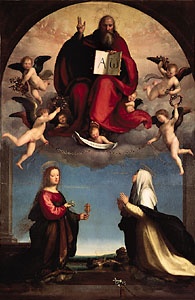Mary Magdalene, Saint
disciple of Jesus
also called Mary of Magdala
flourished 1st century AD, Palestine; feast day July 22
 one of Jesus (Jesus Christ)' most celebrated disciples, famous, according to Mark 16:9–10 and John 20:14–17, for being the first person to see the resurrected Christ.
one of Jesus (Jesus Christ)' most celebrated disciples, famous, according to Mark 16:9–10 and John 20:14–17, for being the first person to see the resurrected Christ.The unchallenged facts about her life establish that Jesus cleansed her of seven demons (Luke 8:2 and Mark 16:9), probably implying that he cured her of a physical disorder rather than the popular notion that he freed her of sins. She was one of the women who accompanied and aided Jesus in Galilee (Luke 8:1–2), and all four canonical Gospels attest that she witnessed Jesus' crucifixion and burial; John 19:25–26 further notes that she stood by the cross, near the Virgin Mary and the unidentified Apostle whom Jesus loved. Having seen where Jesus was buried (Mark 15:47), she went with two other women on Easter morning to the tomb to anoint the corpse. Finding the tomb empty, Mary ran to the disciples. She returned with St. Peter, who, astonished, left her. Christ then appeared to Mary and, according to John 20:17, instructed her to tell the Apostles that he was ascending to God.
The Gospels reveal her to be of practical character. Origen and other early textual interpreters usually viewed her as distinct from the mystical Mary of Bethany, who anointed Jesus' feet and wiped them with her hair (John 12:3–7), and from the penitent woman whose sins Jesus pardoned for anointing him in a like fashion (Luke 7:37–48). The Eastern Church also distinguishes between the three, but after they were identified as one and the same by Pope St. Gregory I the Great, Mary Magdalene's cult flourished in the West. This identification has since been challenged, and modern scholars feel that the three women are distinct.
Gnostics, pre-Christians and early Christians who believed that matter is evil and redemption is attained by an enlightened elite through faith alone, regarded her as a medium of secret revelation, so described in their Gospel of Mary, Gospel of Philip, and Pistis Sophia. According to Eastern tradition, she accompanied St. John the Evangelist to Ephesus (near modern Selçuk, Tur.), where she died and was buried. French tradition spuriously claims that she evangelized Provence (now southeastern France) and spent her last 30 years in an Alpine cavern. Medieval legend relates that she was John's wife.
Additional Reading
Susan Haskins, Mary Magdalen: Myth and Metaphor (1993), traces the development of the myth of Magdalen.
- Gobineau, Joseph-Arthur, comte de
- goblin
- goblin shark
- goby
- Go- Daigo
- God (Anderson, Indiana), Church of
- God and Saints of Christ, Church of
- Godard, Benjamin
- Godard, Jean-Luc
- Godarpura
- Godavari River
- God, Church of
- Goddard Family
- Goddard, Mary Katherine
- Goddard, Paulette
- Goddard, Rayner Goddard, Baron
- Goddard, Robert Hutchings
- God Defend New Zealand
- Godden, Rumer
- Godefroi, comte d' Estrades
- Godefroid de Claire
- Godefroi Estrades, comte d'
- Godefroy Family
- Godert Alexander Gerard Philip, baron van der Capellen
- Godert Alexander Gerard Philip Capellen, baron van der